Featured Comment:
“I always make traditional miso soup, this recipe is delicious, salmon with added vegetables and is perfect to enjoy as one pot dinner for me and family. Thank you.”
– Zoanna
How I Developed This Salmon Miso Soup
Up until now, I’ve made hearty miso soup with proteins such as chicken and pork.
When I had the idea of making miso soup with salmon, I thought of a kind of soup you’d want to have on a cold day in the fall or winter. This inspired me to use seasonal produce such as mushrooms, carrots, and potatoes.
It turned out to be really easy to make and became a filling miso soup that could be served as a hearty side or on its own as a comforting lunch. I’d love for you to give it a try!
Key Ingredients & Substitution Ideas

- Salmon Fillets: Just choose the fresh salmon you like best. My recipe recommends 2 medium fillets for 4 portions, but you can change the amount depending on your preference. The picture above shows 4 mini fillets that are not common to find, and each one is about half the size of a regular fillet.
- Dashi Stock: If you want to get the most authentic taste, I recommend making your own dashi. If you’re short on time, though, high-quality dashi packets are a great alternative. While dashi granules are convenient, they can also add unnecessary extra flavors that might affect the soup’s delicate balance. In my opinion, dashi packets are the best way to go.
- Miso Paste: I recommend using awase miso (also known as “yellow miso” in English), which is a really versatile blend that works perfectly in this soup. For more info on miso varieties and selection tips, check out my comprehensive “Miso 101” article on the blog!
- Vegetables: Start with a hearty base of potatoes, carrots, shimeji mushrooms (or whatever mushrooms you can get locally), and snow peas. This soup is flexible, so feel free to experiment with your favorite vegetables to make it uniquely yours!
- Toppings: I added a small cube of butter for richness and a sprinkle of freshly ground black pepper for a subtle kick.
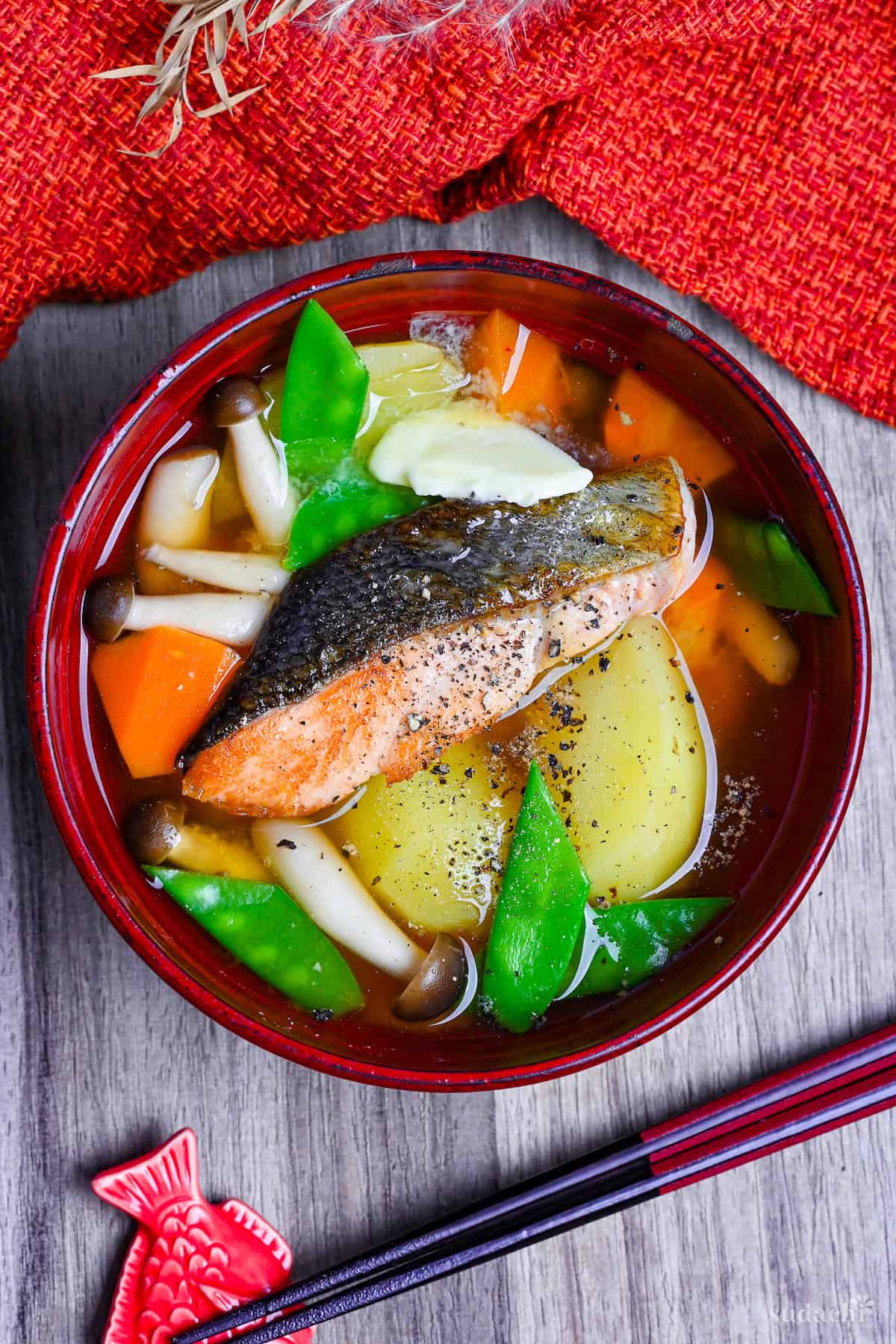
Visual Walkthrough & Tips
Here are my step-by-step instructions for how to make Salmon Miso Soup at home. For ingredient quantities and simplified instructions, scroll down for the Printable Recipe Card below.
If you prefer to watch the process in action, check out my YouTube video of this recipe for a complete visual walkthrough!
Cut the carrots and potatoes into bite-sized chunks.

Give the potatoes a five-minute soak in cold water to get rid of any excess starch.
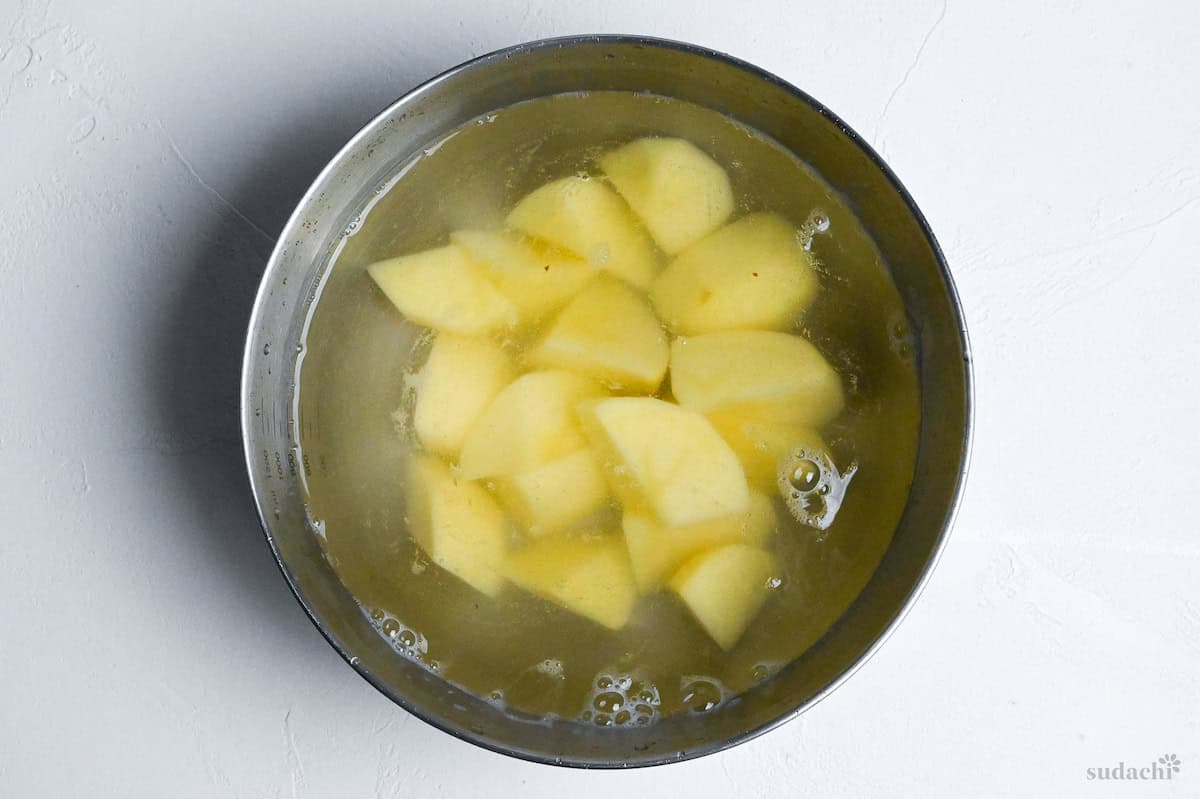
While you’re waiting for the potatoes, heat a small pot of water. Once boiling, blanch the snowpeas for 1 minute, then drain and set aside for later. You can cut them in half once they’re cool enough to touch, then use them as a garnish at the end.
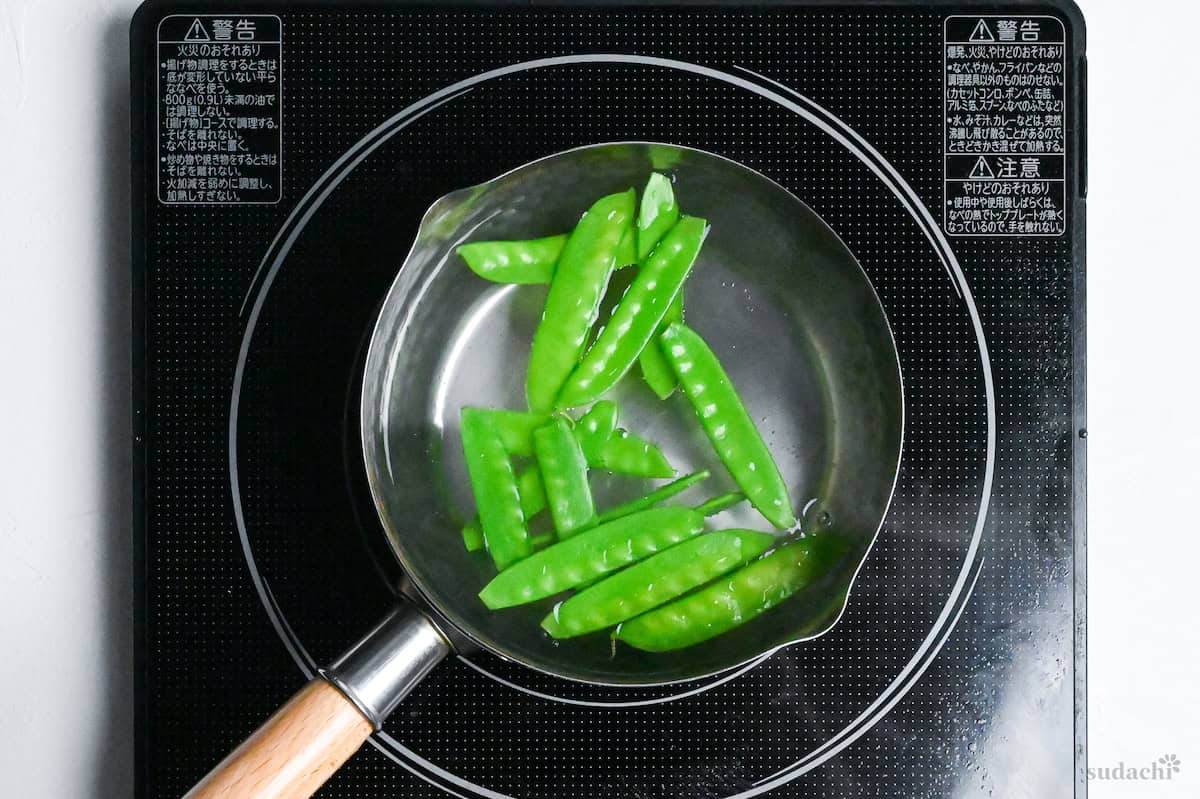
If you’re looking for a quicker option, you can just add the raw snow peas directly to the dashi (soup) with the other vegetables. While blanching makes for a nicer presentation and texture, both methods work perfectly well.
Once soaked, put the drained potatoes and carrots in a microwave-safe bowl with a tablespoon of water. Cover with plastic wrap and microwave on high (600W) for about three minutes to partially cook them.
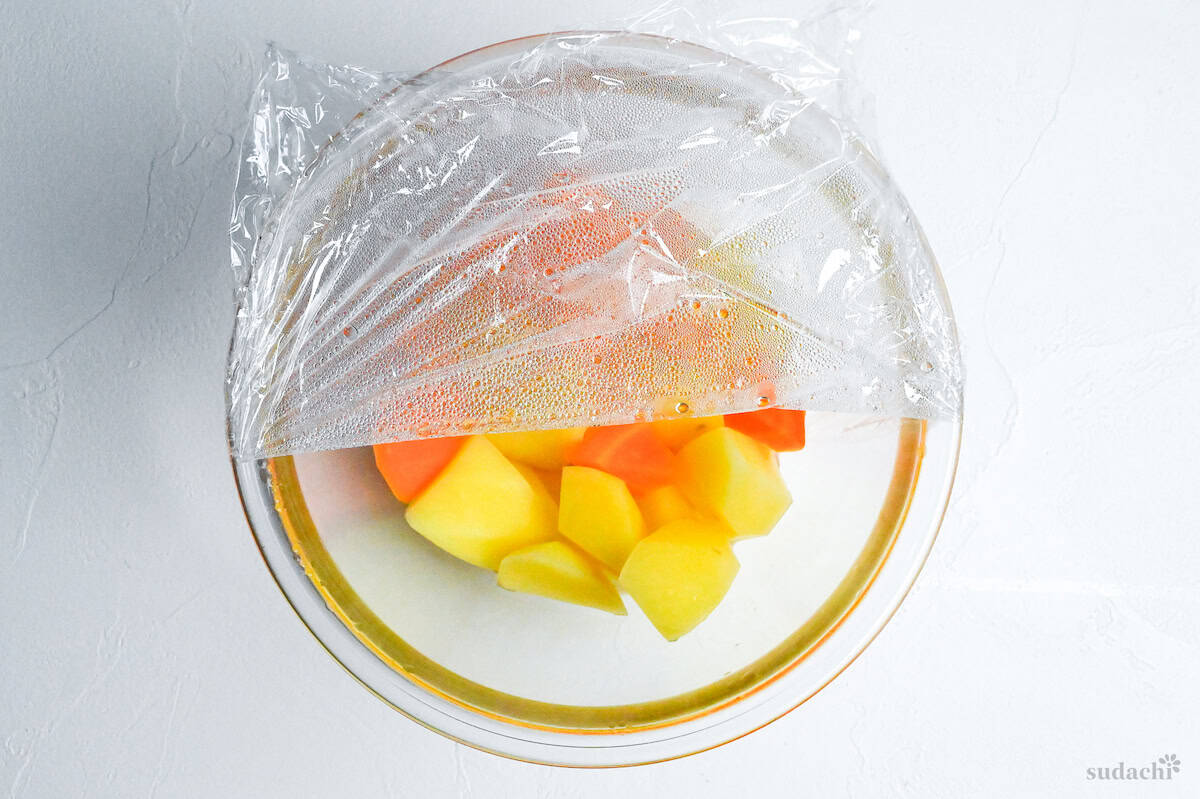
This step is to speed up the cooking process and save time. If you don’t have a microwave, you can parboil the vegetables in a pot of boiling water or use a steamer to steam them instead.
Tip: I don’t recommend boiling the potatoes directly in the dashi as this can make your soup cloudy and starchy.
In a large pot, mix together the dashi stock, the parboiled carrots and potatoes, and the mushrooms.

Bring the mixture to a boil over medium-high heat and cook until the vegetables are softened to your liking.
While the broth is warming up, heat a little oil in a frying pan over medium heat. Sprinkle both sides of the salmon fillets with a little salt and fry them until they’re nicely browned on both sides, which should take about 3 minutes per side.

Once cooked, take them off the heat. Ideally, try and time this so that the salmon is ready at the same time as the soup.
Once you’re happy with the vegetables, turn off the heat and mix in your miso paste.
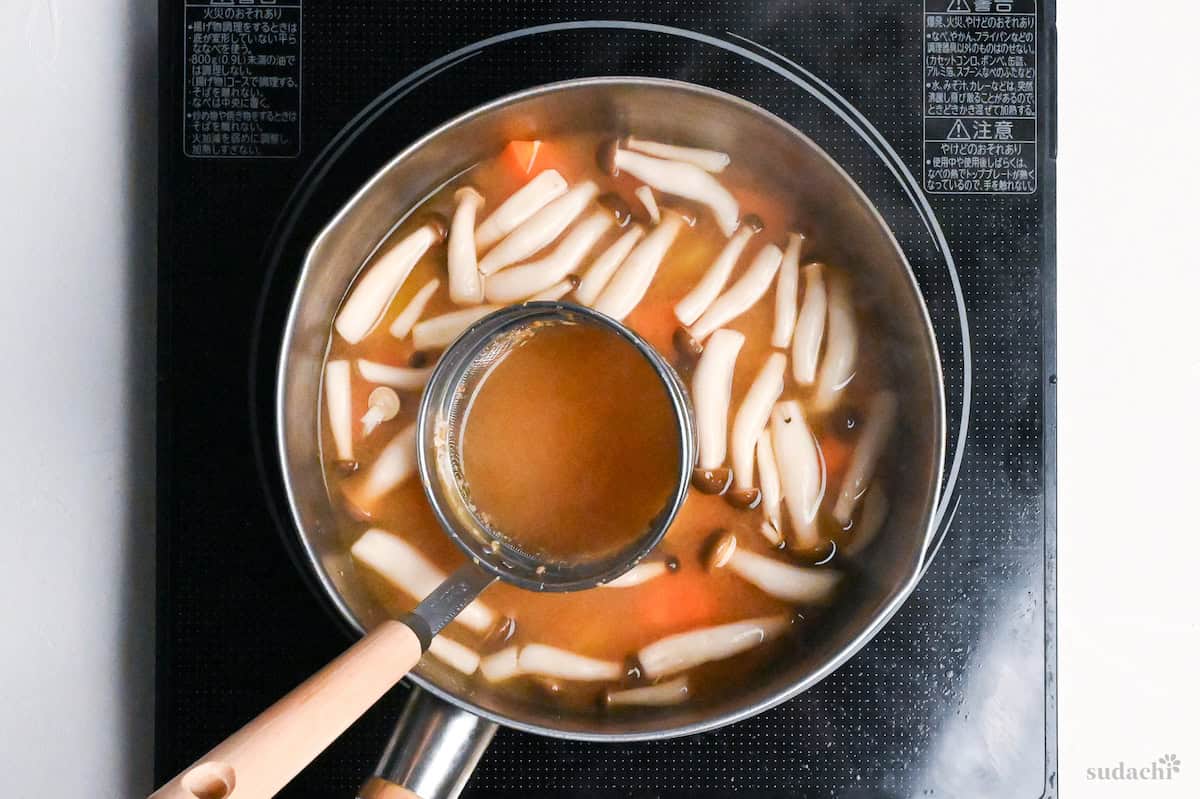
If you just drop the miso paste straight into the pot, you’ll end up with a lumpy soup that is unevenly flavored. For the best results, put the miso on a mesh spoon or ladle, dip it in the broth, and whisk before adding it to the soup. If you don’t have these tools, just whisk the miso paste and a little broth in a small bowl to loosen it before pouring it into the pot.
Split the soup between the serving bowls. Now, add the seared salmon fillets and blanched snow peas. Top each bowl with a small slice of butter and a dash of freshly ground black pepper.
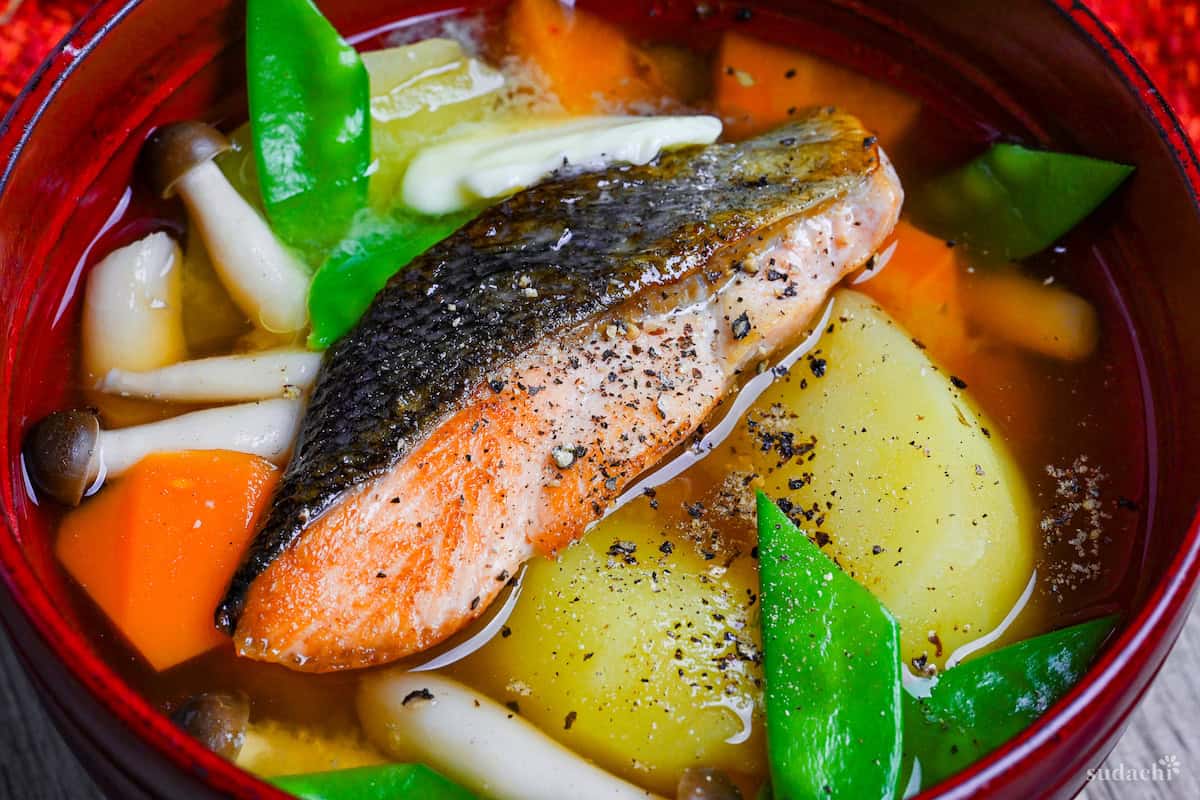
FAQ
Here are answers to frequently asked questions I have received across all platforms, including here, YouTube, Instagram, and Pinterest. If you have any questions, feel free to send them to me anytime! It will be a big help for everyone in this community!
Both methods work! While you can simmer the salmon directly in the soup, I prefer pan-frying it separately first. This creates a better texture and prevents the skin from becoming rubbery.
While this recipe uses yellow miso, you can definitely experiment with different types! White miso works particularly well, offering a milder, sweeter flavor. For a balanced taste, try making yellow miso by mixing equal parts red and white miso. Just remember that different misos vary in saltiness, so always taste and adjust as you go.
Absolutely! While salmon is my top choice for its rich, buttery flavor and texture, this recipe works wonderfully with other fish and seafood too.
I hope you enjoy this Salmon Miso Soup recipe! If you try it out, I’d really appreciate it if you could spare a moment to let me know what you thought by giving a review and star rating in the comments below. It’s also helpful to share any adjustments you made to the recipe with our other readers. Thank you!

More Miso Soup Recipes
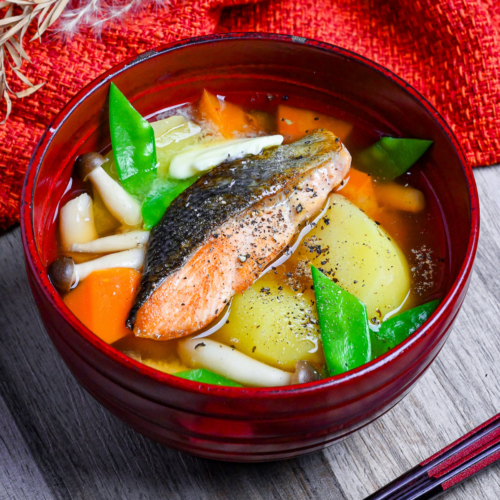
Salmon Miso Soup
Ingredients
- 2 potatoes
- ½ carrot
- 10 snow peas
- 1 tbsp water
- 500 ml dashi stock
- 100 g shimeji mushrooms
- 1 tsp cooking oil
- 2 salmon fillets or double the number of mini fillets
- salt
- 2 tbsp yellow miso paste (awase)
- butter to taste
- ground black pepper to taste
My recommended brands of ingredients and seasonings can be found in my Japanese pantry guide.
Can’t find certain Japanese ingredients? See my substitution guide here.
Instructions
- Peel 2 potatoes and ½ carrot and cut them into bitesize pieces.

- Soak the potatoes in a bowl of cold water for 5 minutes to remove excess starch.

- While you wait, boil a small pot of water and blanch 10 snow peas for 1 minute. After one minute, drain and set aside for later. Once cool enough to touch, cut them in half. Note: this step is mainly for presentation so you can sprinkle them on top at the end. Alternatively, you can add the snow peas later, directly to the pot of dashi in the final minute of cooking.

- Drain the potatoes and rinse them with cold water. Place them in a heatproof bowl along with the carrots and add 1 tbsp water. Cover with plastic wrap and microwave at 600W for about 3 minutes as a shortcut for parboiling. (Alternatively, boil or steam until parboiled.)

- Pour 500 ml dashi stock into a large pot, add the parboiled potatoes, carrots and 100 g shimeji mushrooms, and bring to a boil. Check the carrots and potatoes frequently to ensure they don't overcook.

- In the meantime, heat a frying pan over medium and add 1 tsp cooking oil. Sprinkle 2 salmon fillets (or double the amount of mini fillets) with salt on both sides, then place skin-side down and fry until nicely browned (approx 3 minutes on each side), then remove from the heat and set aside.

- Once the potato and carrots are cooked to your liking, turn off the heat. Place 2 tbsp yellow miso paste (awase) on a mesh spoon or ladle and dip it into the broth, whisking to incorporate it into the dashi and break any lumps.

- Divide the soup into serving bowls and place half a salmon fillet (or whole mini fillet), 5 snow peas and a small square of butter on top of each serving. Sprinkle with ground black pepper to taste. Enjoy!

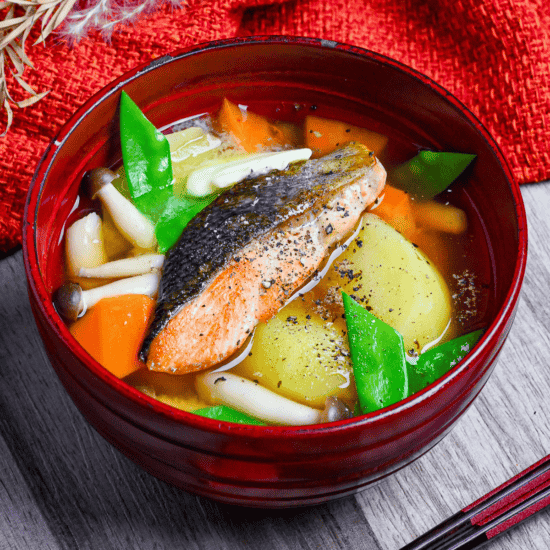



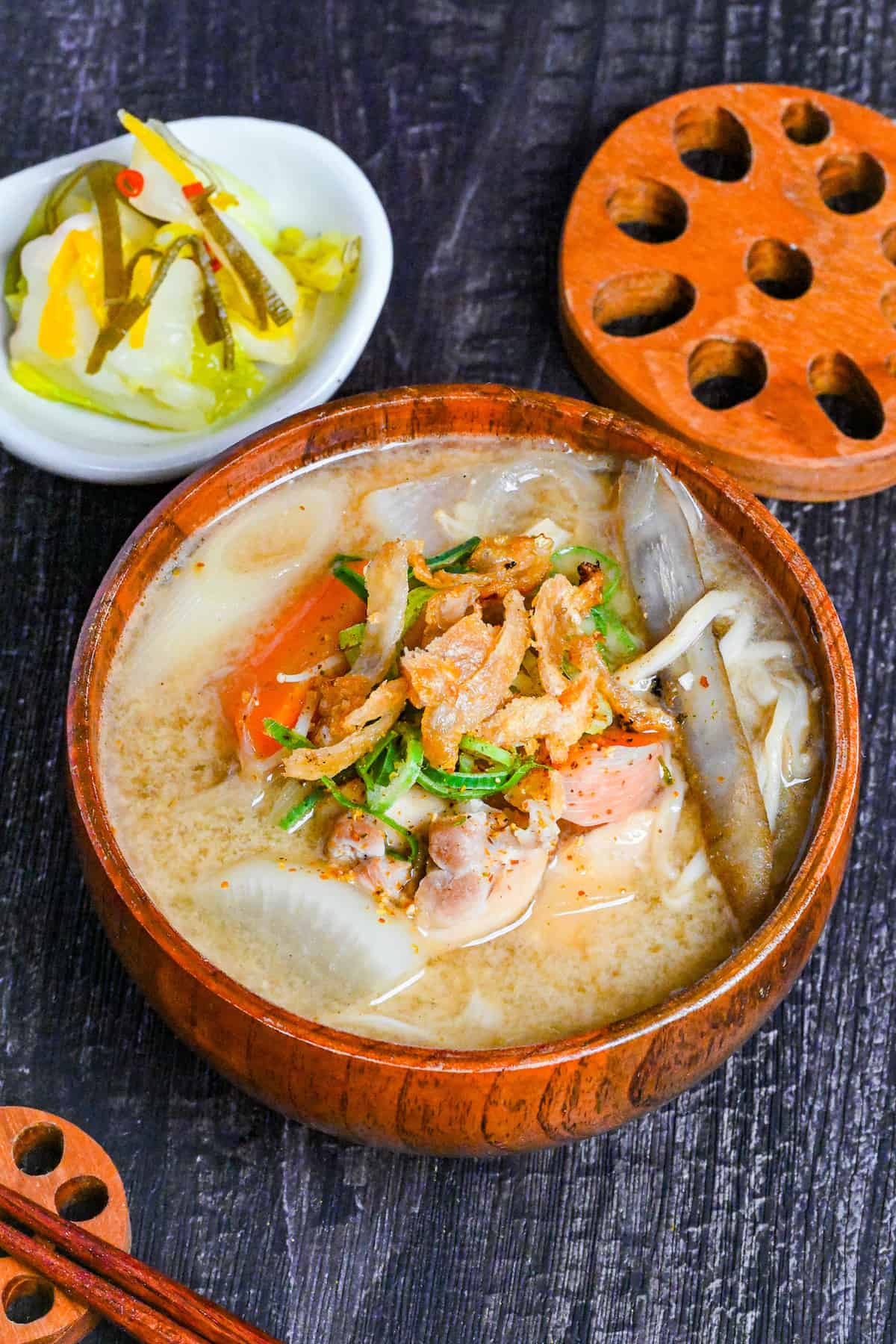


I always make traditional miso soup, this recipe is delicious, salmon with added vegetables and is perfect to enjoy as one pot dinner for me and family. Thank you.
Hi Zoanna,
Thank you so much for making this recipe! I’m so happy that this was well received by a miso soup fan! 🙂
Yuto
I made this recipe with dried shitake mushrooms we grew. I had never used or made dashi before when making miso soup. It came out so rich and so much more flavorful. We were very happy with this recipe and will definitely make it again. Also, instead of snow peas (not available) I used roasted geen onions and corn.
Hi Jeffrey,
Thank you for trying this recipe! That’s amazing that you used home grown shiitake mushrooms! I’m so happy you enjoyed the recipe and plan to make it again!
Yuto